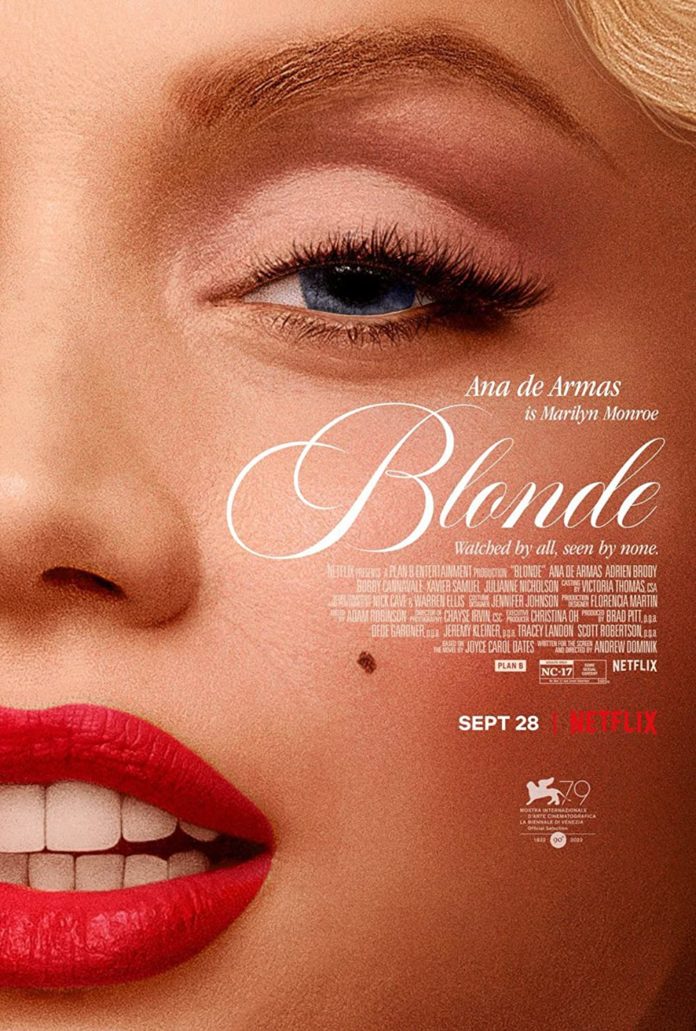Biopics are nothing new. A renowned actor or actress brings an iconic figure back to life on the big screen in some original way. Awards pundits hail this actor’s take as being one of the best of the year simply because of how well the actor can imitate the icon’s voice or mannerisms, for example. In the end, it doesn’t matter what’s in the script—all that matters is how the actor’s portrayal resurrects their subject and how convincing their performance is to the audience.
Director Andrew Dominik’s “Blonde” attempts to rewrite the cursed shelf life of biopics. His take on Marilyn Monroe’s life is based on a 2000 novel by Joyce Carol Oates and features Ana de Armas in the leading role. Rather than simply describe Monroe’s rise to fame through the film industry, Dominik’s film decides to change the narrative and focuses on some of her spiral into the abyss—albeit in a completely fictional tale.
At times the film feels like a highlight reel of Marilyn Monroe’s worst moments, but Dominik attempts to provide Monroe with humanity. The film covers most of the blonde bombshell’s life, from her youth living with her abusive and mentally unstable mother to her death by overdose. Like a typical biopic, the film hits on the moments as she climbs the Hollywood social ladder, but “Blonde” decides to take an alternate look at Monroe by focusing on the men in her life.
From the absent father she never met, the studio executives who take advantage of her, boyfriends, husbands, and even JFK himself, “Blonde” deals with the male gaze in a way that has enveloped Marilyn Monroe’s entire career. Male fans have fawned over the actress not for her incredible acting talents, but solely for her looks. Dominik decides that, rather than viewing Monroe as a person, his film should focus on Monroe as an icon. The exploitive manner in which he does this, primarily by testing the limits with excessive nudity and the MPAA’s NC-17 rating, feels extremely grotesque.
But then again, this is not your standard biopic, nor should it even be considered a biopic. “Blonde” may revolve around one of history’s most iconic actors, but its story was never advertised as a historical retelling. Instead, Oates’s novel and Dominik’s film are meant to be dark fairy tales of Marilyn Monroe. Therein lies the issue: Monroe has been constantly vilified by the press and public since entering Hollywood at such an early age. A film that continues this trend nearly 100 years after her birth feels rather fainéant.
While it is hard to overlook controversy over the film’s script, it is hard to disregard the other factors that ultimately make “Blonde” such an ambitious film. After witnessing the different elements, from the euphoric score by Nick Cave and Warren Ellis to the luscious cinematography by Chayse Irvin (who has done previous work on music videos such as Beyoncé’s “Lemonade”), it is devastating that this film will forever live on simply as one of the millions of options to watch on Netflix on your smartphone rather than on a 50-foot theater screen.
Audiences will never be able to experience Ana de Armas’s captivating performance the way it was meant to be viewed. The up-and-coming actress, known for “Knives Out” and “Blade Runner 2049”, gives this role her all. She dons the iconic tousled curls and beauty mark on her right cheek and truly becomes Monroe. Her soft, delicate imitation of Monroe’s voice allows her to quietly deliver a powerful execution that reigns as her career’s best.
While it is hard not to simply reenact mannerisms of an icon such as Marilyn’s whose entire life was captured on film by either the press or in her films, de Armas, like Oates and Dominik, crafts a new version of the character. de Armas knows how to charm the audience. Her performance allows viewers to get into Monroe’s head and encounter each emotion de Armas puts on the screen.
Ultimately, once the controversy over the ethics of the film’s script is placed in the backseat, audiences can begin to really experience the vision that Dominik had when crafting this film. Although messy in context, it is executed so ambitiously. Despite its nearly three-hour runtime, “Blonde” feels like it flashes before your eyes once the fever dream crashes to a halt in the film’s haunting and poignant final moments. Just like the well-known image of Marilyn Monroe’s flying skirt over the sidewalk grate, “Blonde” will stay in the minds of audiences for years to come.








